Tim Sawyer - Chess Strategy Queen’s Knight: How to Beat Intermediate Chess Players (Sawyer Chess Strategy Book 17)
Here you can read online Tim Sawyer - Chess Strategy Queen’s Knight: How to Beat Intermediate Chess Players (Sawyer Chess Strategy Book 17) full text of the book (entire story) in english for free. Download pdf and epub, get meaning, cover and reviews about this ebook. year: 2022, genre: Home and family. Description of the work, (preface) as well as reviews are available. Best literature library LitArk.com created for fans of good reading and offers a wide selection of genres:
Romance novel
Science fiction
Adventure
Detective
Science
History
Home and family
Prose
Art
Politics
Computer
Non-fiction
Religion
Business
Children
Humor
Choose a favorite category and find really read worthwhile books. Enjoy immersion in the world of imagination, feel the emotions of the characters or learn something new for yourself, make an fascinating discovery.
- Book:Chess Strategy Queen’s Knight: How to Beat Intermediate Chess Players (Sawyer Chess Strategy Book 17)
- Author:
- Genre:
- Year:2022
- Rating:4 / 5
- Favourites:Add to favourites
- Your mark:
Chess Strategy Queen’s Knight: How to Beat Intermediate Chess Players (Sawyer Chess Strategy Book 17): summary, description and annotation
We offer to read an annotation, description, summary or preface (depends on what the author of the book "Chess Strategy Queen’s Knight: How to Beat Intermediate Chess Players (Sawyer Chess Strategy Book 17)" wrote himself). If you haven't found the necessary information about the book — write in the comments, we will try to find it.
Tim Sawyer illustrates chess strategy from games played vs random Advanced players as Guests on chess.com. The book has 37 games with 172 diagrams. These lines can surprise your unprepared opponents. Opening theory and endgame knowledge help your play, but tactics win most games.
The author uses strategy for many comments to explain whats going on. He follows any of these steps. 1. Describe the current position. 2. Imagine how to improve it. 3. Plan how to get there.
Tim picks a key position every few moves to make a comment. His plan is for you to browse through the book, look at the diagrams and read the comments with ease.
For those who prefer to read quickly, you can skim through the book from diagram to diagram. Note the change from the previous diagram and read any notes that interest you.
Sometimes a line of chess engine analysis is added. You may wish to work out those lines in your head, or just note that there was an alternative way to play and keep reading.
Tim Sawyer played chess for 50 years. As a Postal Chess Master, his usual opponents were rated 1800 to 2400. However, opponents in this book are often lower to intermediate. Tims peak Internet Chess Club blitz rating was 2492.
The author assumes that you can read algebraic chess notation. The diagrams have White at the bottom of the board. Thank you for reading. Enjoy this one!
Tim Sawyer: author's other books
Who wrote Chess Strategy Queen’s Knight: How to Beat Intermediate Chess Players (Sawyer Chess Strategy Book 17)? Find out the surname, the name of the author of the book and a list of all author's works by series.


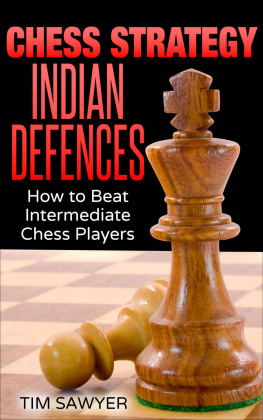

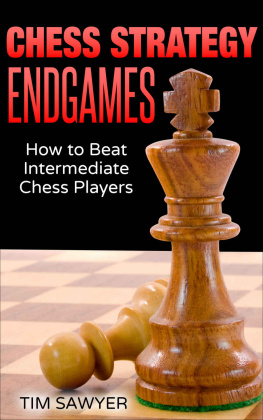
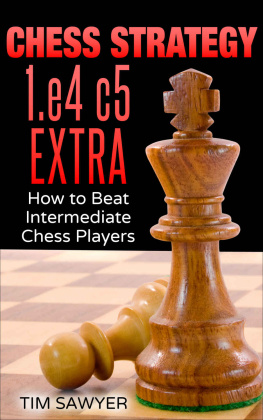
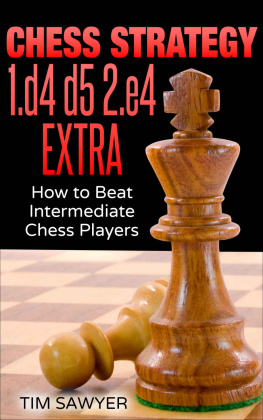
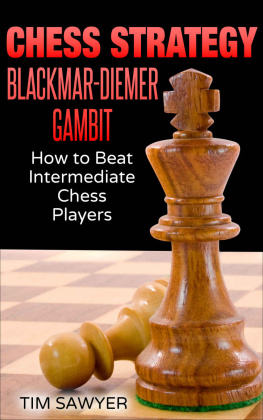
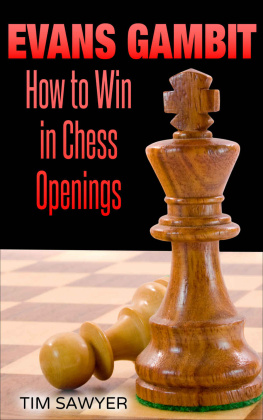
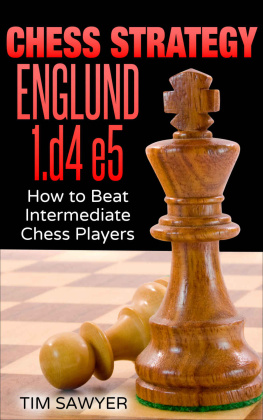
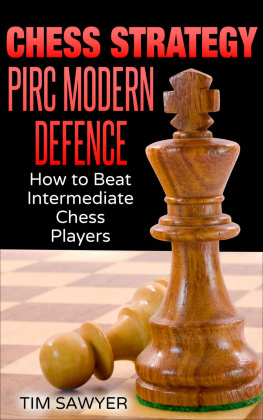

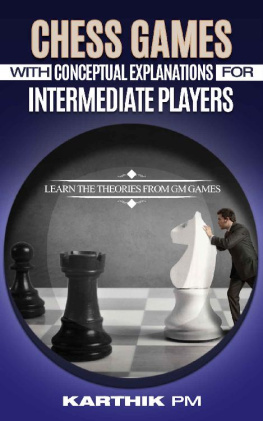
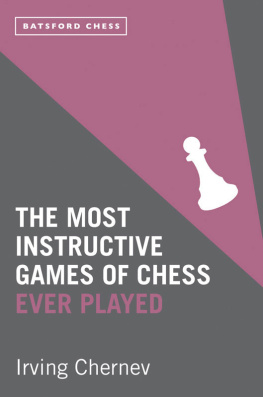
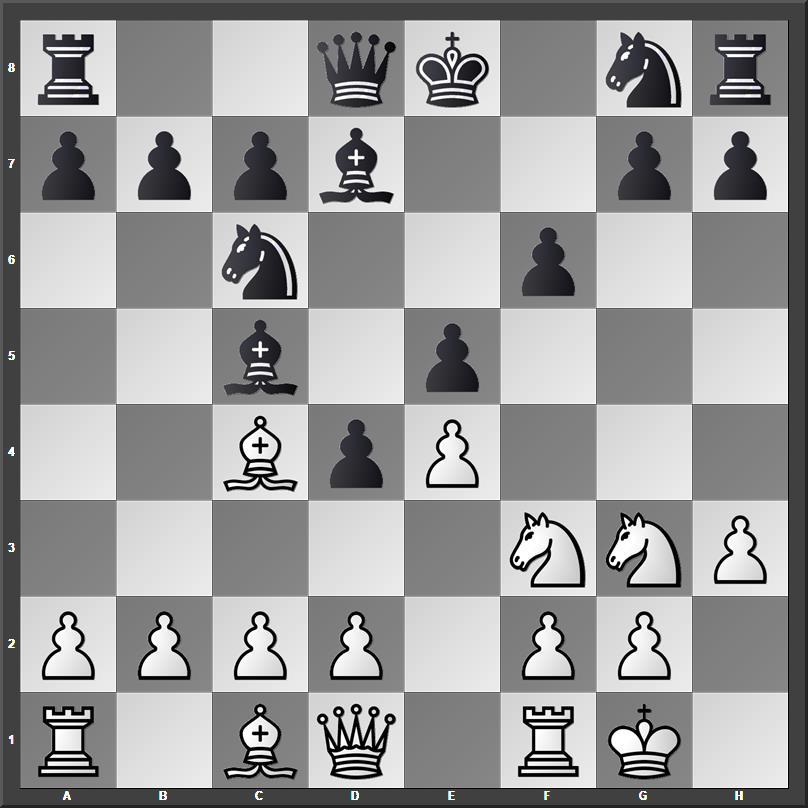 Now White could try 9.c3 with a good position. 9.d3 a6 10.a3 b5
Now White could try 9.c3 with a good position. 9.d3 a6 10.a3 b5 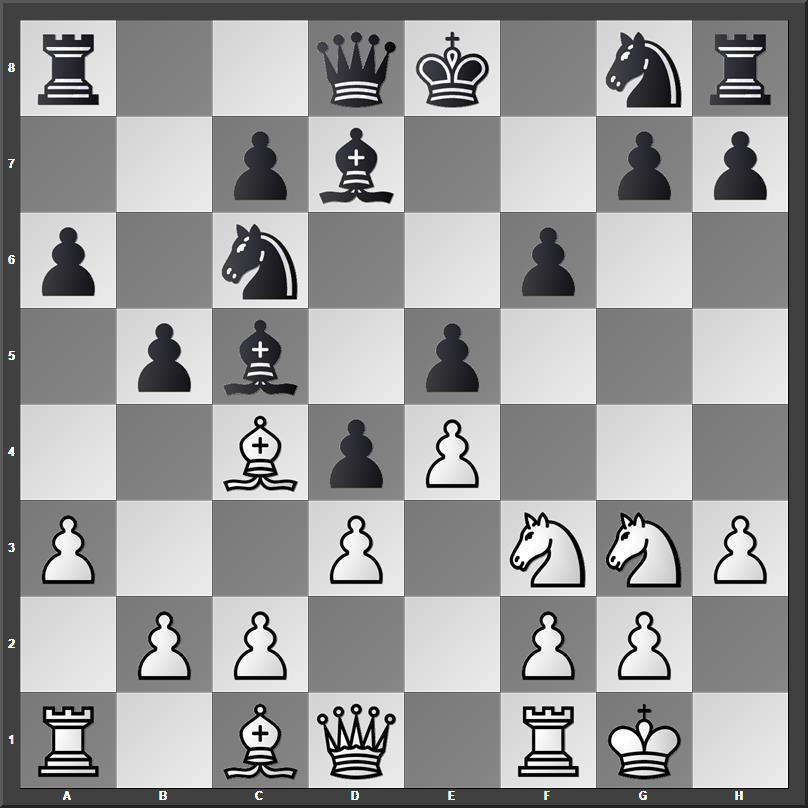 I thought about 11.Bd5 Nge7 but I missed the follow-up with 12.Nh5 when White has an advantage. 11.Ba2 Nge7 12.Nh5 g5 Maybe 12...Kf8 13.Nh4 Be8 14.Nxf6 gxf6 15.Bh6 mate. 13.Nxf6+ 10 If 13...Kf8 14.Nxg5 and White has won two pawns with the two kingside knights. 13.Nxf6+ 10 If 13...Kf8 14.Nxg5 and White has won two pawns with the two kingside knights.
I thought about 11.Bd5 Nge7 but I missed the follow-up with 12.Nh5 when White has an advantage. 11.Ba2 Nge7 12.Nh5 g5 Maybe 12...Kf8 13.Nh4 Be8 14.Nxf6 gxf6 15.Bh6 mate. 13.Nxf6+ 10 If 13...Kf8 14.Nxg5 and White has won two pawns with the two kingside knights. 13.Nxf6+ 10 If 13...Kf8 14.Nxg5 and White has won two pawns with the two kingside knights.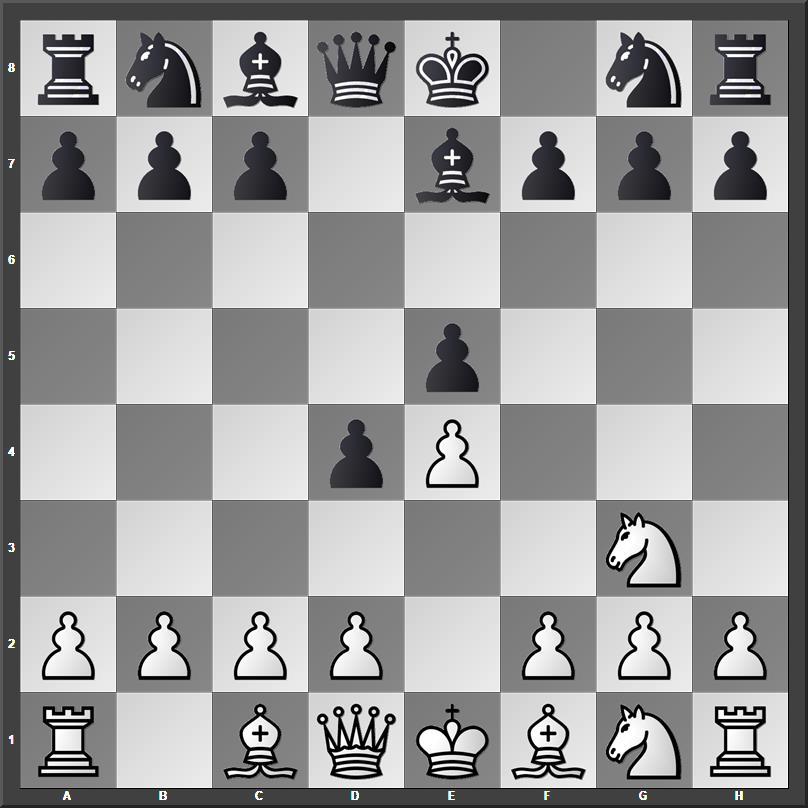 5.Nf3 Another approach is to play 5.c3 with or without d3. 5...Bg4 6.Bc4 6.h3 Bxf3 7.Qxf3 and White stands a little better. 6...Bf6 Better is 6...Nc6 with equal chances. 7.h3 Bxf3 8.Qxf3 Ne7
5.Nf3 Another approach is to play 5.c3 with or without d3. 5...Bg4 6.Bc4 6.h3 Bxf3 7.Qxf3 and White stands a little better. 6...Bf6 Better is 6...Nc6 with equal chances. 7.h3 Bxf3 8.Qxf3 Ne7 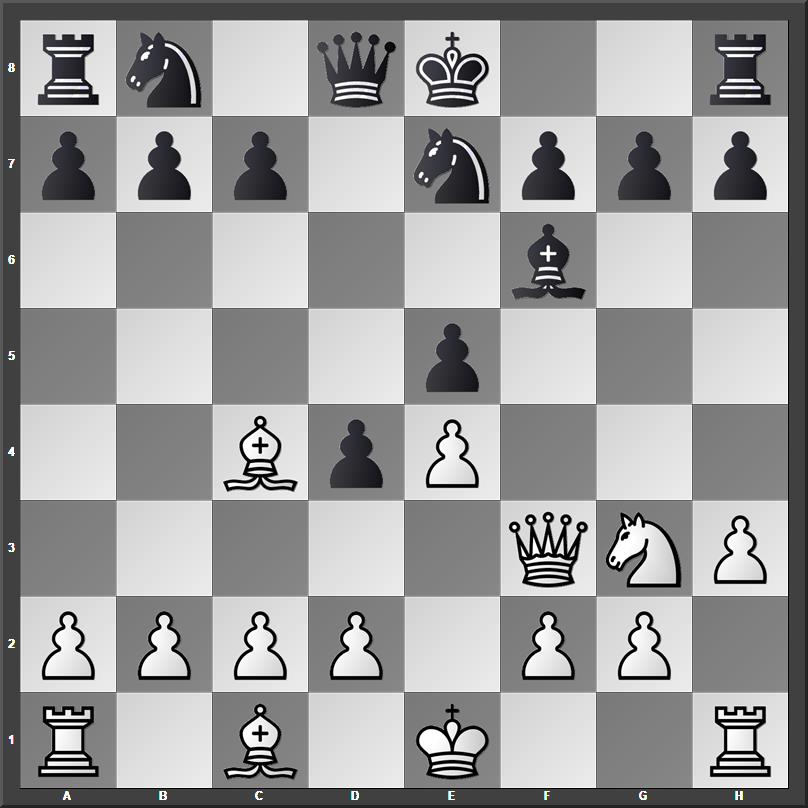 9.Nh5 Ng6 Or 9...00 10.Nxf6+ gxf6 11.d3 favors White. 10.Nxg7+ Kf8 [10...Kd7 11.Nh5 Be7 12.Qxf7 and White is winning.] 11.Nh5 Nd7 12.d3 Nc5
9.Nh5 Ng6 Or 9...00 10.Nxf6+ gxf6 11.d3 favors White. 10.Nxg7+ Kf8 [10...Kd7 11.Nh5 Be7 12.Qxf7 and White is winning.] 11.Nh5 Nd7 12.d3 Nc5  13.Bh6+ Kg8 14.Qxf6 Qxf6 15.Nxf6# 10 Thats a beautiful finish. 5.Bc4 h6 6.Nf3 Nf6 7.d3 00 8.00 a6 A good approach here is 9.Bd2 b5 10.Bb3 c5 11.a4 and if 11...c4 12.dxc4 bxc4 13.Bxc4 White is up pawn. 9.c3 b5
13.Bh6+ Kg8 14.Qxf6 Qxf6 15.Nxf6# 10 Thats a beautiful finish. 5.Bc4 h6 6.Nf3 Nf6 7.d3 00 8.00 a6 A good approach here is 9.Bd2 b5 10.Bb3 c5 11.a4 and if 11...c4 12.dxc4 bxc4 13.Bxc4 White is up pawn. 9.c3 b5 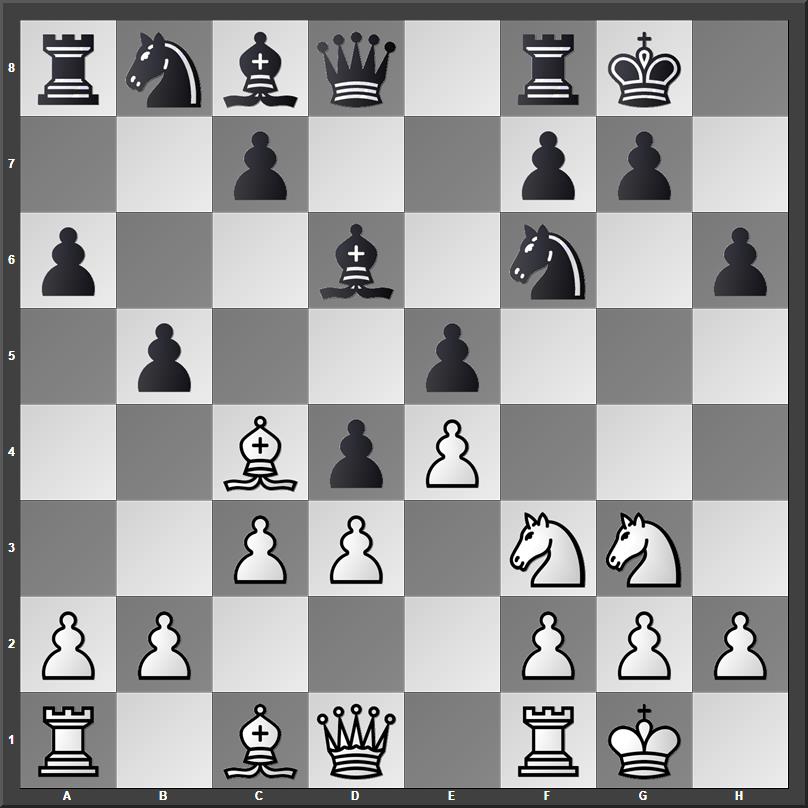 White should consider 10.cxd4 bxc4 11.dxe5 Nxe4 12.Nxe4 Be7 13.dxc4 with two extra pawns. 10.Bb3 c5 11.a4 b4 12.cxb4 cxb4 13.Nd2 a5 14.Nc4 Ba6 15.Nxd6 Qxd6 16.Nf5 Qc7 17.f4 Nbd7
White should consider 10.cxd4 bxc4 11.dxe5 Nxe4 12.Nxe4 Be7 13.dxc4 with two extra pawns. 10.Bb3 c5 11.a4 b4 12.cxb4 cxb4 13.Nd2 a5 14.Nc4 Ba6 15.Nxd6 Qxd6 16.Nf5 Qc7 17.f4 Nbd7 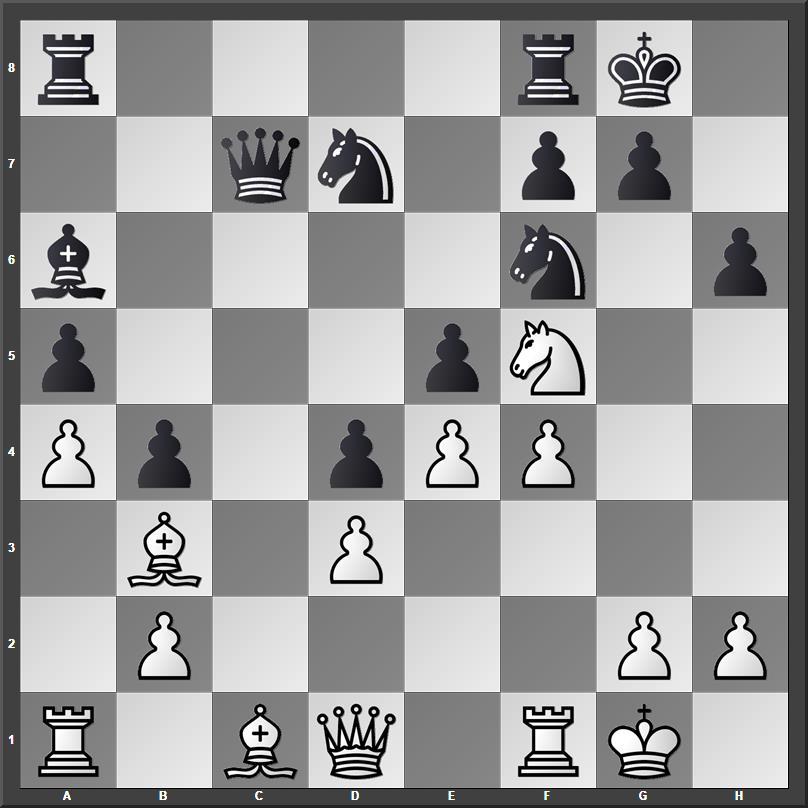 I missed 18.fxe5 Qxe5 19.Bf4 with a promising attack. 18.Ne7+ Kh8 19.Nd5 Nxd5 20.Bxd5 Rab8 21.fxe5 Nxe5 22.Bf4 f6 23.Rc1 Qe7 24.Bxe5 Qxe5
I missed 18.fxe5 Qxe5 19.Bf4 with a promising attack. 18.Ne7+ Kh8 19.Nd5 Nxd5 20.Bxd5 Rab8 21.fxe5 Nxe5 22.Bf4 f6 23.Rc1 Qe7 24.Bxe5 Qxe5 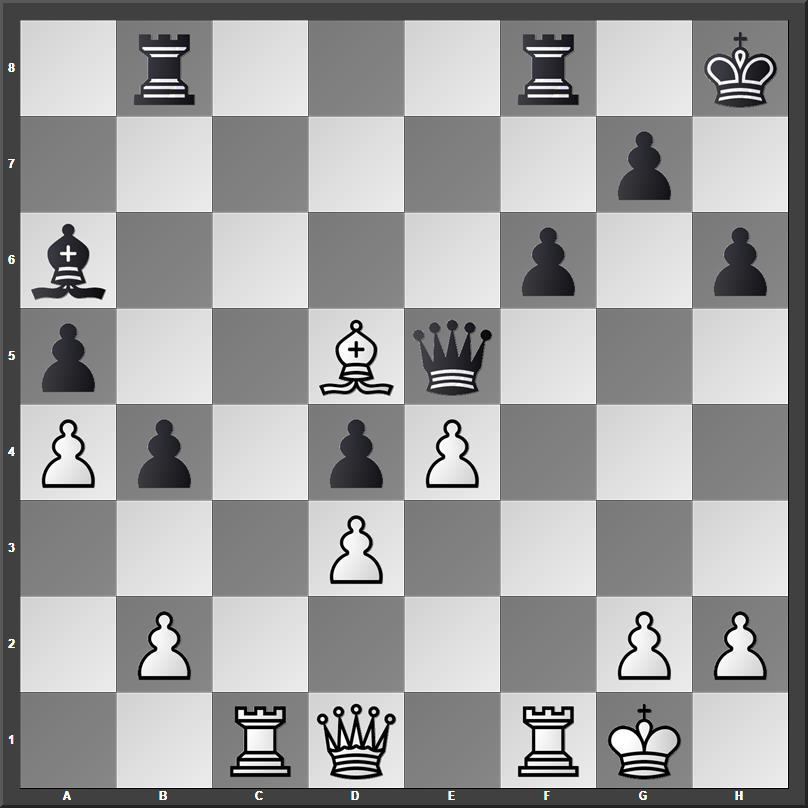 25.Rf5 Qe7 26.Bc4 Bxc4 27.Rxc4 g6 28.Rxa5 f5
25.Rf5 Qe7 26.Bc4 Bxc4 27.Rxc4 g6 28.Rxa5 f5 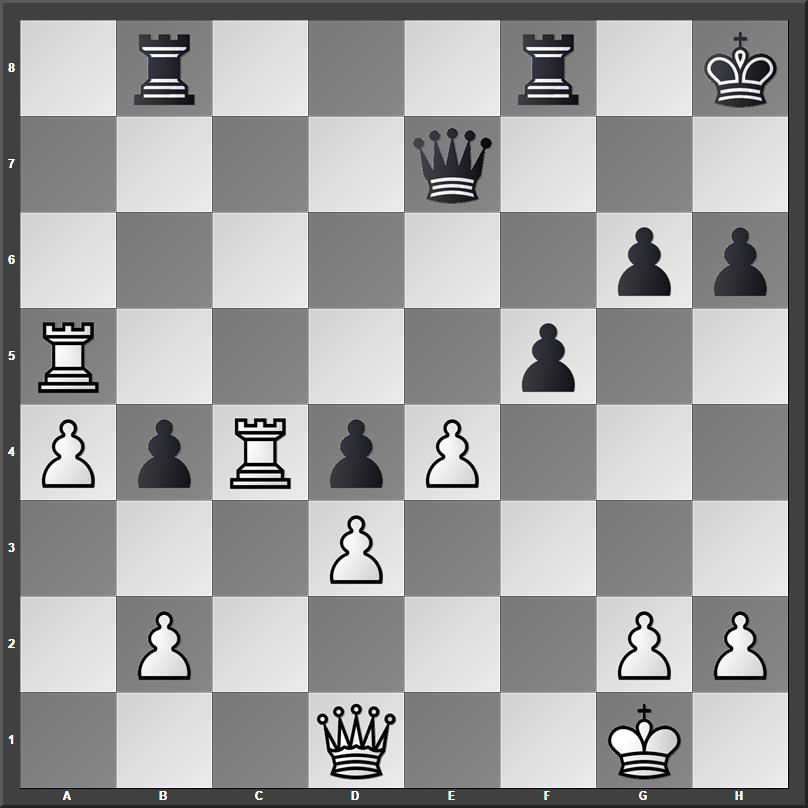 A powerful move is 29.Qc1 threatening Qxh6 and Rc7. 29.Rxd4 fxe4 30.Rxe4 Qg5 Another try is 30...Qf6 31.Qe2 Qb6+ 32.Qe3 Qxa5 33.Qxh6+ Kg8 34.Qxg6+ Kh8 35.Rh4+ Qh5 36.Rxh5 mate. 31.Rxg5 10 Black resigns
A powerful move is 29.Qc1 threatening Qxh6 and Rc7. 29.Rxd4 fxe4 30.Rxe4 Qg5 Another try is 30...Qf6 31.Qe2 Qb6+ 32.Qe3 Qxa5 33.Qxh6+ Kg8 34.Qxg6+ Kh8 35.Rh4+ Qh5 36.Rxh5 mate. 31.Rxg5 10 Black resigns 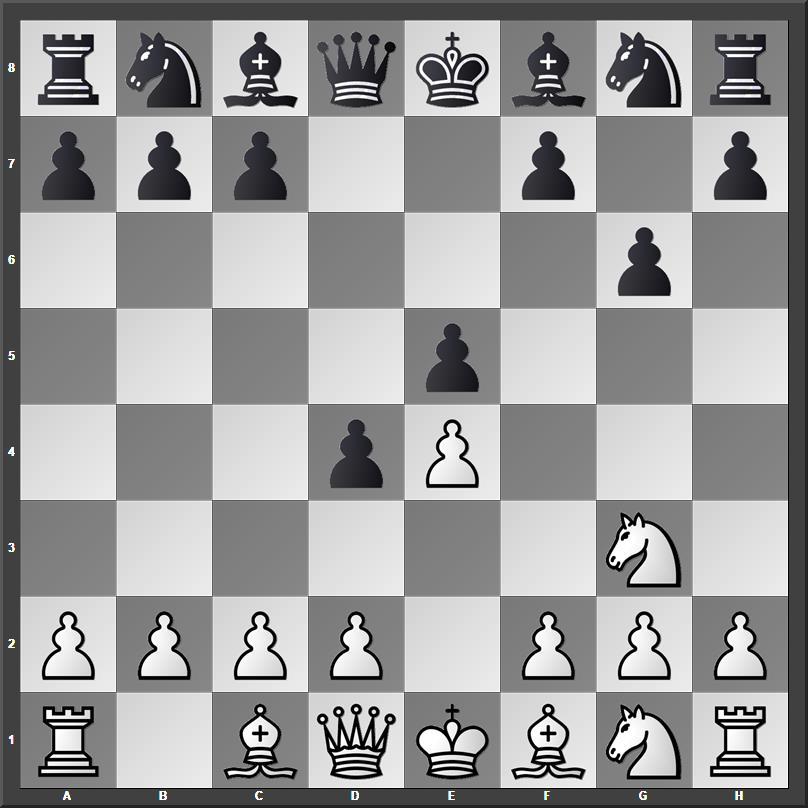 Blacks g6 pawn prevents Nh5 or Nf5 and may allow Bg7. 5.Nf3 Bd6 6.Bc4 h6 Or 6...c5 7.d3 h6 8.00 with a typical position. 7.c3 dxc3 8.bxc3 c6 9.d4 exd4
Blacks g6 pawn prevents Nh5 or Nf5 and may allow Bg7. 5.Nf3 Bd6 6.Bc4 h6 Or 6...c5 7.d3 h6 8.00 with a typical position. 7.c3 dxc3 8.bxc3 c6 9.d4 exd4  Now 10.Qxd4 Rh7 11.e5 Bc7 12.Qe4 which favors White. 10.cxd4 b5 11.Bb3 a5 12.a3 b4 13.axb4 Bxb4+ 14.Bd2 Bxd2+ 15.Qxd2 Ba6
Now 10.Qxd4 Rh7 11.e5 Bc7 12.Qe4 which favors White. 10.cxd4 b5 11.Bb3 a5 12.a3 b4 13.axb4 Bxb4+ 14.Bd2 Bxd2+ 15.Qxd2 Ba6 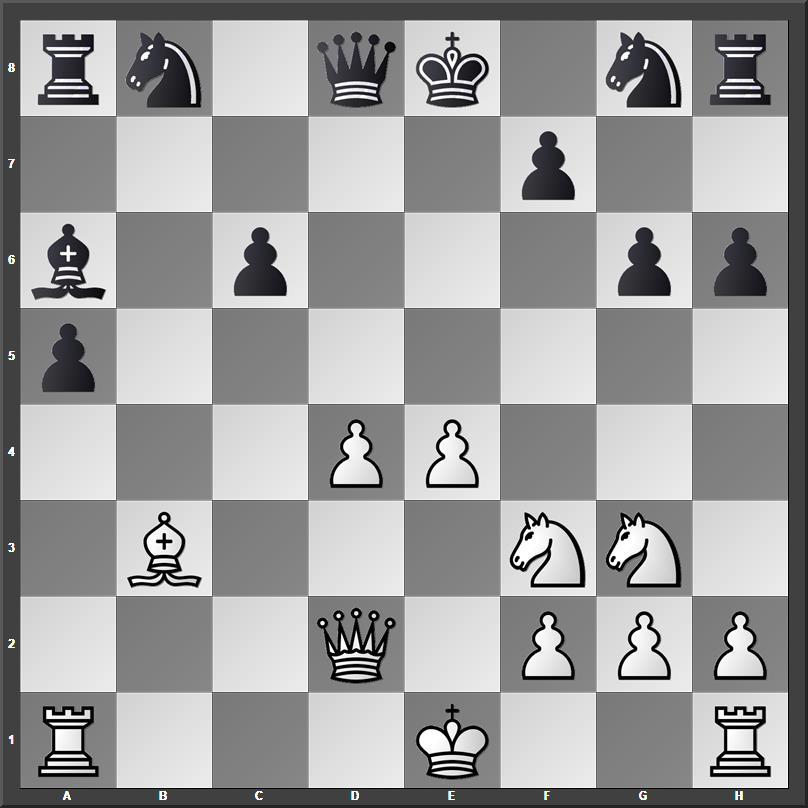 16.Qxa5 Qe7 After 16...Qxa5+ 17.Rxa5 Ne7 18.Kd2 Nd7 19.Rha1 Rb8 20.Bxf7+ Kxf7 21.Rxa6 Rb2+ 22.Ke1 White is up 2 pawns. 17.Qe5 Qxe5 18.Nxe5 Rh7 19.Bc4 Bb7 20.Rxa8 Bxa8 21.00 Ne7
16.Qxa5 Qe7 After 16...Qxa5+ 17.Rxa5 Ne7 18.Kd2 Nd7 19.Rha1 Rb8 20.Bxf7+ Kxf7 21.Rxa6 Rb2+ 22.Ke1 White is up 2 pawns. 17.Qe5 Qxe5 18.Nxe5 Rh7 19.Bc4 Bb7 20.Rxa8 Bxa8 21.00 Ne7 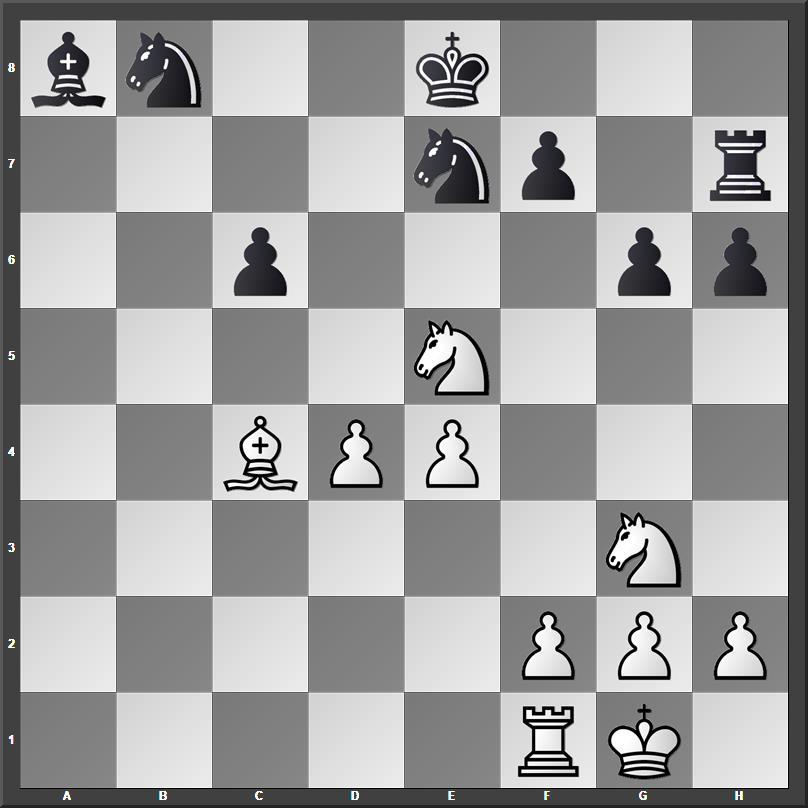 Now if 22.Ra1 Bb7 23.Rb1 f6 24.Ng4 White is winning. 22.Bxf7+ Rxf7 23.Nxf7 Kxf7 24.Ra1 10 Now 24...Bb7 25.Rb1 and White wins the bishop or knight. 22.Bxf7+ Rxf7 23.Nxf7 Kxf7 24.Ra1 10 Now 24...Bb7 25.Rb1 and White wins the bishop or knight.
Now if 22.Ra1 Bb7 23.Rb1 f6 24.Ng4 White is winning. 22.Bxf7+ Rxf7 23.Nxf7 Kxf7 24.Ra1 10 Now 24...Bb7 25.Rb1 and White wins the bishop or knight. 22.Bxf7+ Rxf7 23.Nxf7 Kxf7 24.Ra1 10 Now 24...Bb7 25.Rb1 and White wins the bishop or knight.